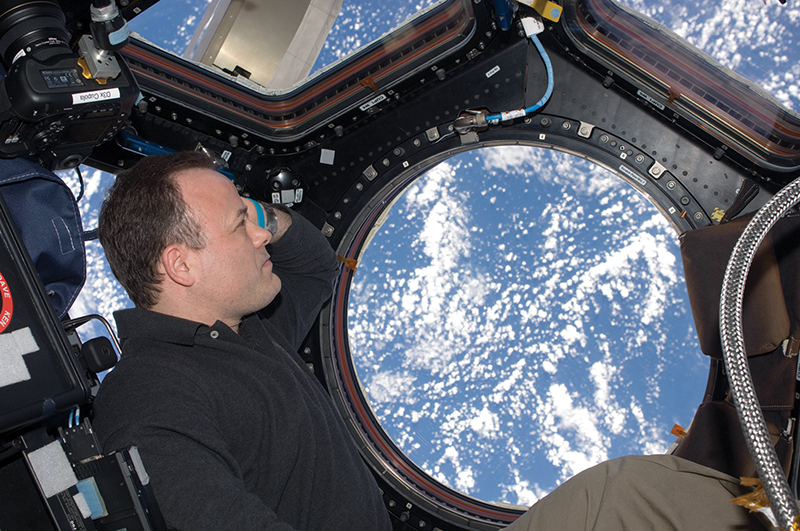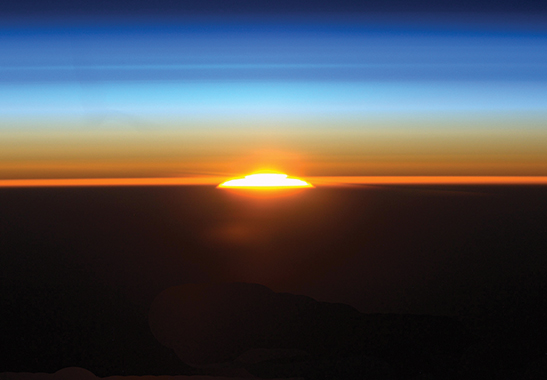
Innovative Software Tools Measure Behavioral Alertness
NASA Technology
For astronauts working aboard the International Space Station (ISS) in low-Earth orbit, getting adequate sleep is a challenge. For one, there’s that demanding and often unpredictable schedule. Maybe there’s an experiment needing attention one minute, a vehicle docking the next, followed by unexpected station repairs that need immediate attention. Next among sleep inhibitors is the catalogue of microgravity-related ailments, such as aching joints and backs, motion sickness, and uncomfortable sleeping positions.
And then there is the body’s thrown-off perception of time.
Because on the ISS the Sun rises and sets every 45 minutes, the body’s circadian rhythm—the internal clock that, among its functions, regulates the sleep cycle based on Earth’s 24-hour rotation—falls out of sync.
“They go to the cupola and look at these incredible sunrises just before they’re supposed to go to bed,” says NASA flight surgeon Smith Johnston, who is chief of the Fatigue Management Team, “and it gives the astronaut a giant dose of light that suppresses your melatonin and keeps you from being able to sleep.”
In order to steady the brain’s production of melatonin, enabling some sleep stability, astronauts shield their windows from all sunlight and wear face masks. For its part, the medical team back on Earth also constantly monitors their health and can, among a number of measures, prescribe medications to balance circadian rhythms or help to resolve other sleep-related problems.
Why so much attention is paid to making sure astronauts get enough slumber time is simple: The demands placed on an astronaut—who must both subsist in an artificial environment and carry out mission objectives—require that he or she operate at peak alertness.
Long-distance verbal check-ins with medical personnel is one way crewmembers communicate their levels of alertness, but the Agency is currently evaluating the utility of technology that provides a quantitative measure of a person’s vigilance at any given time. The innovation has the potential to improve the health and performance of not only astronauts but also the many people who engage in similar high-risk activities.
Technology Transfer
In the early-1980s, David Dinges, a professor of psychology in psychiatry at the University of Pennsylvania Perelman School of Medicine and among the world’s preeminent sleep experts, developed what has become one of the most widely used tests for determining behavioral alertness. The Psychomotor Vigilance Task (PVT) is a test that requires a person to watch a screen for a light stimulus and press a response button as quickly as possible when the light is detected. The light comes on repeatedly at random intervals of a few seconds until enough responses are acquired to establish—to the millisecond—the speed of the subject’s visual reaction times. The test yields results for the stability of focused attention by measuring the number of errors of omission (performance lapses) and errors of commission (impulsive responses). By detecting these performance changes, the PVT records the degree of deficits in alertness and vigilant attention, as well as response speed.
Although the traditional 10-minute PVT was practical for laboratory studies and clinical trials that, for example, gauge the effects of experimental sleep loss or the effects of psychoactive medications on human alertness, its duration made it less than ideal as a test for astronauts working in space, given their limited discretionary time.
“Every minute is just precious to us,” says NASA’s Johnston, “and there’s so much to get done, and it’s also a matter of having the astronauts be focused on their tasks and not getting sidetracked for too long a time.”
So in the mid-2000s, Dinges and his colleague Mathias Basner from the same institution, with funding from NASA and the National Space Biomedical Research Institute, began working on a 3-minute version of the PVT for astronauts. The challenge lay in developing and validating an algorithm that could produce results that were nearly as sensitive as the results produced using the 10-minute version. Development began by measuring astronaut PVT performance during four NASA Extreme Environment Mission (NEEMO) operations, where astronauts perform duties in an underwater research facility where the environment closely resembles that of space. The results from those tests gave Dinges and Basner the data needed to optimize an algorithm, in part by determining how well an astronaut could react to the test when he or she is operating at peak alertness. Those reaction times would form the basis of a performance score used by astronauts on the PVT-B (the “B” is for brief) on the International Space Station. As they made substantial progress toward achieving these goals, it was clear that other aspects of the test would also need to be improved for use in space.
For one, the traditional PVT portable test device was cumbersome—not conducive for the limited confines of a spacecraft or the ISS. What was needed was a PVT that added little or no mass. Also essential was that it become a self-test; the program needed to be simple enough for an astronaut to use without any assistance.
That is where Philadelphia-based software engineering firm Pulsar Informatics came into play. Pulsar’s president and CEO Daniel Mollicone trained with Dinges at the university en route to earning his doctorate in biomedical engineering. In 2006 Dinges asked Mollicone, who had worked on NASA projects in the past, if the company could develop the software for ISS.
It was not a simple request. Applying technology that was once carried out by a dedicated machine onto programs that run on personal computers, which is what astronauts use in space, is complicated by the fact that personal computers are not specifically designed to collect reaction times with the high precision essential for rapid objective evaluation of alertness. The PVT requires that reaction times be precisely measured in the milliseconds—that is, in thousandths of a second. But the company’s engineers were up to the challenge: They had previously developed a proprietary robotic calibration system that could overcome such problems. Pulsar and NASA quickly entered into a contract to support a collaborative team of scientists and engineers lead by Dinges to develop a version of the PVT suitable for use by astronauts during space missions.
“We were young, ambitious engineers, and we were developing tools of similar nature and had the basic capability, so we agreed to take it on,” Mollicone says.
Benefits
Being able to constantly react quickly when required to do so is essential for astronauts because space missions can pose dangerous situations that require fast and accurate reactions. The PVT-B Self Test was renamed by NASA for ISS as the Reaction Self-Test. It informs astronauts when their performance drops below optimal ranges.
Since 2009, astronauts have been using the software on the ISS in order to gather data on the impact of certain space flight conditions (e.g., elevated workloads and reduced sleep time) to validate the PVT Reaction Self-Test as a useful operational support tool for astronauts.
When an ISS astronaut performs the Reaction Self-Test and receives feedback from the test indicating a diminished behavioral alertness performance score, the tool is essentially providing a warning sign indicating caution. “That’s when the astronaut may consult with their flight surgeon to implement some fatigue countermeasures that get the astronaut back up to peak alertness”, says Mollicone. Fatigue countermeasures might take the form of various sleep medications, mandated days off, power naps, and pushed back mission timelines, among others.
NASA flight surgeon Smith Johnston says the potential for the shortened PVT test is promising. “Daniel (Mollicone) and his team is currently working on developing a mission support software dashboard for flight surgeons that will use results based on each astronaut’s PVT performance to create models so we know how well the astronaut is coping with or reacting to his or her environment,” says Johnston. “It’s a critical feedback tool, and once it’s integrated into an operational tool, it’s going to be amazing.”
And it’s not just NASA that’s benefitting from the 3-minute self-test. Pulsar Informatics has contracts with other government agencies, namely the Department of Transportation and the Navy.
“The Navy has to be ready 24 hours a day, 7 days a week,” says Mollicone. “And as we’re heading toward a Navy with more automation aboard ships, each crew member is given more responsibilities. We’re working to make sure that personnel are getting adequate rest so they can do their jobs reliably.”
Trucking companies and commercial airlines use the self-test to better understand operational fatigue in order to prevent their drivers and pilots, respectively, from getting into fatigue-induced accidents. Mollicone says the test would be perfect for all drivers, noting that up to 40 percent of road accidents are caused by fatigue.
“When people get high fatigue scores on the PVT they always say, ‘I had no idea I was this impaired. I had no idea I needed to get some sleep,’” he says. “The test has the potential to save lives.”
The uptick in Pulsar’s business over the last several years seems to suggest that more and more people and organizations are recognizing the importance of managing fatigue. Since partnering with NASA 5 years ago, the number of full-time engineers and computer developers has grown from 3 to 24. Revenues have grown, on average, 75 percent every year.
“Because of the collaboration with NASA, we’ve had this incredible success,” Mollicone says. “And we’re excited to continue pushing the limits of this technology for use here on Earth, where it’s every bit as relevant.”

One of 15 sunsets astronauts experience each day while onboard the ISS.

NASA astronaut Dottie Metcalf-Lindenburger practices simulated space maneuvers on the ocean floor near Key Largo during NASA Extreme Environment Mission Operations (NEEMO) 16 in June 2012. Astronauts there took the 3-minute PVT test to help refine the algorithm for use in actual orbit. Inset: NASA Flight Surgeon Josef F. Schmid works with the PVT in NEEMO’s Aquarius underwater habitat.

While sleeping, astronauts in space must tether themselves to the floor. They also often use facemasks to block out the light, helping to induce sleep.

NASA astronaut Ron Garan views a point on Earth through one of the windows in the cupola of the International Space Station (ISS). The 15 sunrises and sunsets that occur on the ISS in a 24-hour period disrupt crewmembers’ sleep patterns.













